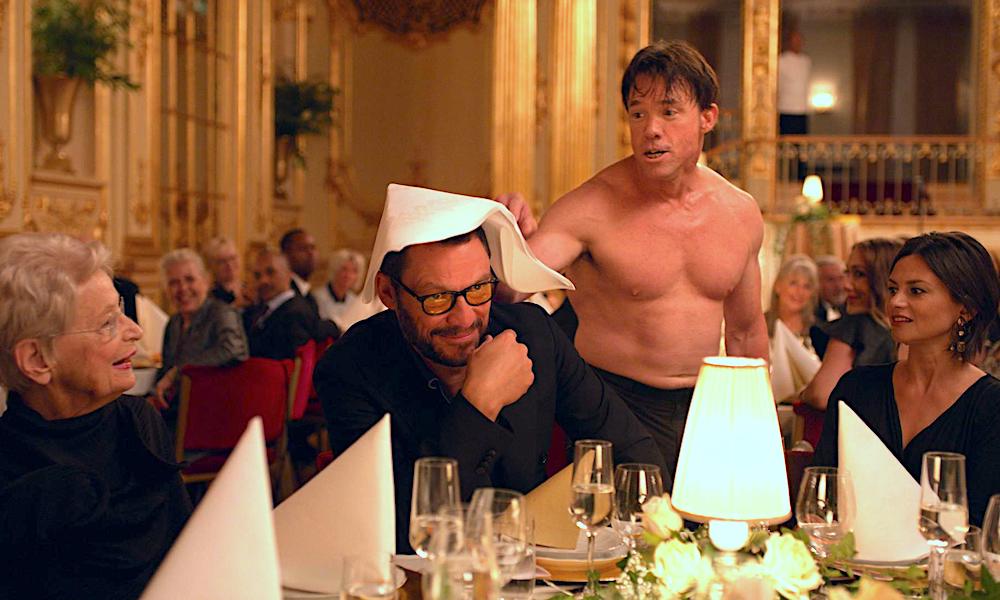Ostlund is showing his cards from the opening scene, letting the viewer in on the kinds of questions he wants to ask. The film begins with the theft of Christian’s wallet by some industrious pickpockets who reenact a mugging to distract their mark. Christian gets to play the hero and is exhilarated by the experience, only to find that his pockets have been emptied. He paid a price for a visceral emotional reaction, but he deems that price as too costly, and sets out to get his things back. The Square repeatedly puts costs on experiences and asks if they’re worth it. The various means of measuring cost, whether it’s endorphins or clicks or the story one now gets to tell, are treated the same as dollars and cents, placing value in the ephemeral along with the monetary. Christian is repeatedly shown to value his pride and sense of himself far more than any of the above, as he will often place himself into a situation and then ruin it for the sake of his self-aggrandizement. He’s an affable-enough person, but he has zero ability to laugh at himself, taking himself as seriously as someone who would pile up dirt and call it a museum exhibit.
That inability to call a pile a pile is one form of self delusion in an upper class society teeming with them. Christian is an able stand-in for the Swedish rich, as he’s been elevated to the status of tastemaker, and it’s easy to imagine his comrades feeling about themselves the same way he does. Tolerance is at the top of the hierarchy, a virtue Ostlund skewers in a scene that’s bludgeoning but still funny in a Sideshow-Bob-stepping-on-rakes way. Dominic West plays a pompous artist, and while being interviewed by Christian, a man with Tourette’s cannot stop yelling ‘Bullshit’ from out in the crowd. There are few easier jokes, but West’s character is in desperate need of comeuppance in that moment. The scene gains a new wrinkle when some patrons complain while others plead for indulgence of a sick man, even to the point of their inability to hear what West is saying. The man who pled for tolerance surely felt great about himself, though the reason for his being there was unable to get any of his thoughts out.
The greatest delusion Christian and the rest share is that they’re good people. The virtue signaling that Christian and so many others engage in is intolerable, as if they know how decadent and indulgent their lives are and desperately need to keep up appearances with public charitable donations that in no way impede their ability to live a 1% lifestyle. The museum is housed in the former royal palace, one form of aristocracy making way for another. Instead of inbreeding and divine right placing society’s chosen at the top of the heap, it’s now the ability to make up nonsense and call it valuable, a magic trick that creates vast wealth and self-congratulation out of, again, piles of dirt. Within its walls, patrons pat each other on the back for their philanthropy and good taste while without, if the people who lived in public housing could see what these people spent their fortunes on, they would reenact the storming of the Bastille. Ostlund shows how prevalent homeless people are in Stockholm, and he repeatedly includes solictors who’ve upped their rhetoric to ‘How would you like to save a life today?’ No one important is looking, so these people get consistently ignored.
If the art on display were more entrancing or impressive, The Square wouldn’t have the same bite. More leeway would be given to the purveyors if they were purveying something valuable. However, the artists on display are telling instead of showing, which is just a chance for them to moralize. The experience of the work is more valuable than the work itself, which again, elevates the theatrical pickpockets from the intro. The centerpiece scene is a performance artist at a gala, in character as a confrontational chimpanzee. The sequence is a cinematic show-stopper with a masterful demonstration of stuntman and motion capture actor Terry Notary’s skills, but as modern art, it’s not that much more impressive than a committed mime. There’s grandiosity there, but little else. This sliding scale of simply making things grand and ostentatious instead of meaningful results in the trash art of viral marketing, which is utilized for promotion of the Square exhibit. Controversy generated by the tone-deafness of the ad itself, hilarious in how oblivious it is, is less important than the clicks and views it generates, finally reducing creation to a metric that’s easily digestible. Why dress up piles of dirt as an existential statement for no one to see, when there’s youtube hits to capture? Never mind if any of it is actually any good.
Bang is a worthy foil for Ostlund’s barbs. He’s a nebbish in a movie star’s body, constantly getting himself stuck in awkward moments that make him worthy of teasing, if not derision. He’s the unabashed center of the film, with more recognizable actors like Moss and West relegated to a handful of scenes. She is a reactor to the world around her, like the art world is not her usual beat, and the constant state of rubber-face she’s in is perfectly demonstrative of the Royal’s layers of absurdity. Ostlund piles it on in scene after scene, making The Square a surprise at every turn. Some heavy-handedness is excusable when a film is as fun as this one. At one point, a character advises another to ‘Stop acting so Swedish.’ Whatever amount of Swedish Ostlund is being in creating these penetrative satires is the exact right amount. A-

 RSS Feed
RSS Feed